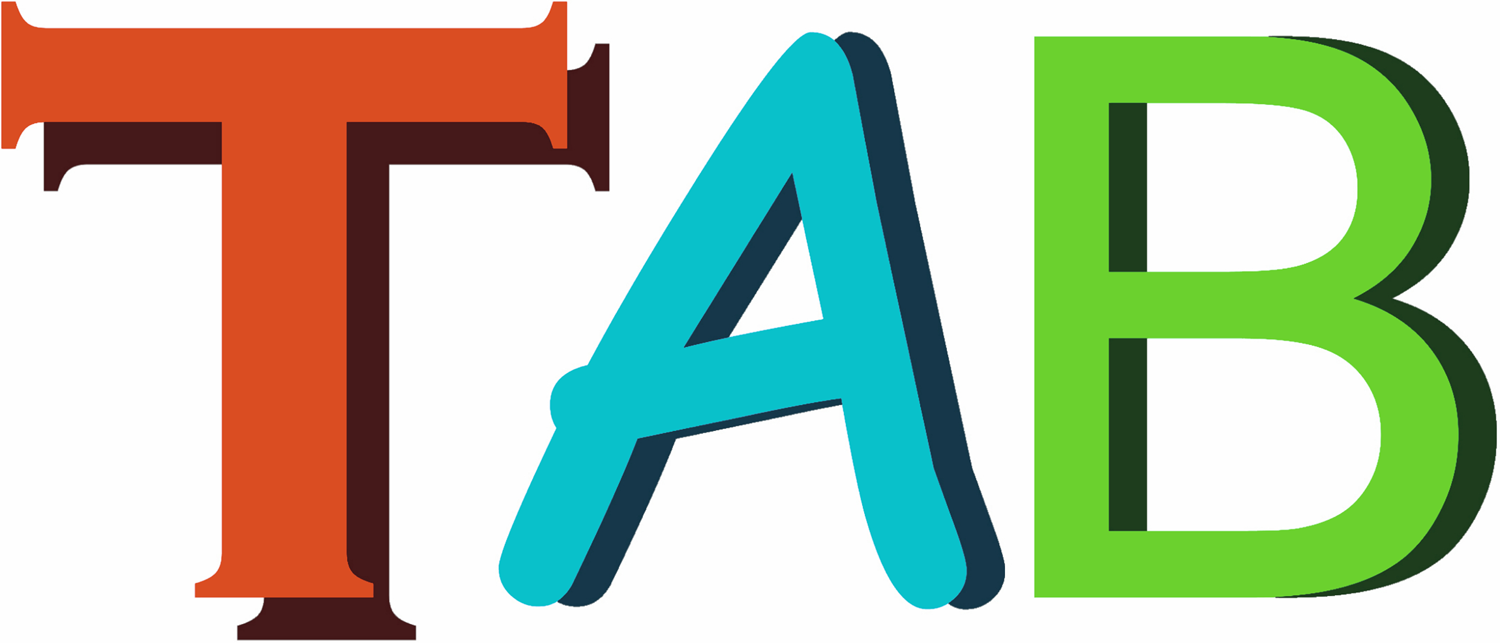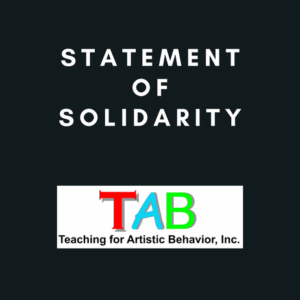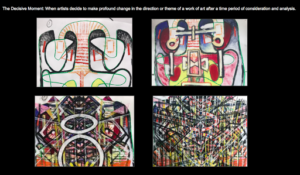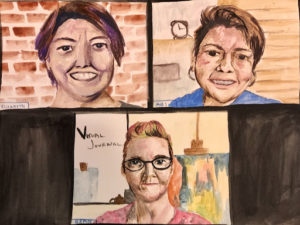By Claire Winkeler
When I took a nine year unintentional detour to become a kindergarten classroom teacher, I had no idea it would turn out to be more relevant to my practice as an art teacher than any of the art teaching I’d done in previous years. Returning to a full-time art position, I picked up where I had left off, leading students through projects and directing each step along the way. But the process that I’d honed for years now seemed wholly inadequate, especially for my youngest students. In search of something more satisfying and appropriate, I stumbled upon TAB, which turned out to be the perfect solution to developing a program that suited all of my students’ different needs.
I read the books, joined the groups, attended workshops, observed lots of talented teachers, and I determined that implementing TAB for my older students seemed pretty straight forward. But my youngest students – preschool, kindergarten and even first grade seemed to need something a little different to bring them into the fold.
One of the driving concerns I had in creating a program that suited preschool and kindergarten was they needed to move and do it at their own pace. The amount of sustained, high quality attention to any activity you can expect from a young child is somewhere in the ballpark of the number of minutes that correspond to their age. Four-year-olds can keep it together for about four minutes. If they find an activity that truly captures their interest, they might become engrossed for much longer. This especially applies to activities they have designed or created through play. When students come to my classroom, they can move freely from center to center as long as there is space. I create enough spaces so that there are always multiple options when they are ready to move on. They can stand at the table or sit on the floor if that suits them best. I don’t put minimum or maximum time limits on centers because some children will complete an idea or task and be ready to move in five minutes, while others might be playing out the story they’ve created until class is over. Large chunks of uninterrupted time for children to develop their ideas are rare. Their recess is probably less than fifteen minutes. Center rotations in their classroom might change every ten minutes. Extended time is a luxury I can offer that pays itself back in less anxiety, frustration and behavior issues. If someone doesn’t get a turn, they know the center will be available until interest dwindles and something new pops up in its place.
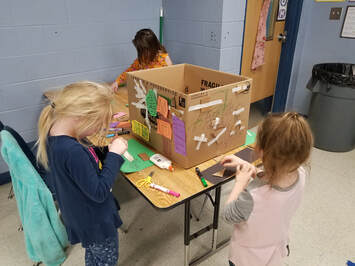
Creating centers that allowed for play was also a top priority.
Play has been stripped down – if not completely cut out of most early childhood programs. It’s been replaced by bulky, incoherent curriculums and assessments. There is no lack of research on the benefits of play for young (and old) children, so if anyone ever questions my methods, I feel like I can come at them locked and loaded with an arsenal of expert information. And now I can also point them towards the National Visual Art Standards that tell us preschoolers should “engage in self-directed play with materials,” and kindergarteners should “engage in exploration and imaginative play with materials.” So there! In my classroom we play. We build zoos and houses and boats with blocks, we bake cookies with playdoh, we make silly faces out of shapes on felt boards, we construct super hero cuffs and magic wands from paper and tape. Play is a child’s expression, and what do artists do? They express themselves.
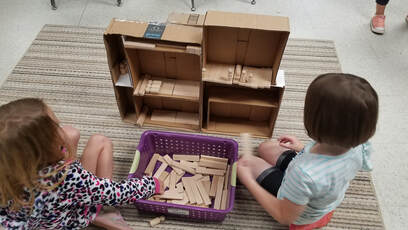
With those two guiding principles in place, I set about creating routines and systems to allow them to be successful doing things on their own. Ultimately, I’m preparing them for a fully independent TAB experience, so they will need to have some executive functioning skills. For choosing centers, we learn to count the chairs at table centers or remember the number of spots for floor centers. When I see a student wandering aimlessly, we conference and figure out what is open and come up with a plan for where they want to work. I put hand washing buckets where they can reach them, and I put step stools around the room to help them reach things. My students are small, but capable, and they might just need a boost. For clean-up, all the table centers can be put away into one or two clear plastic shoe boxes. I model this and we practice it, at first with the least messy materials and then, one at a time, we add in the wet and sticky centers. It can take weeks and sometimes months to learn these routines. At first, clean-up will seem like utter chaos. More than half of the students will be playing with something they’ve made, attempting to keep working, or just wandering around to find their friends. Somehow the messes will get worse before they get better. But we chip away at it class by class, revisit expectations, model and practice, and eventually the chaos upgrades to controlled instead of utter. At the end of class, after the whirlwind of cleaning up, we sing songs, nursery rhymes and fingerplays to settle down and bring the children together as a group.
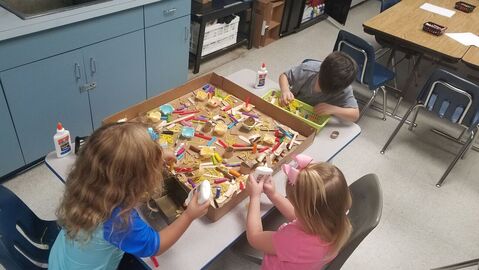
The rest of the program is a variety of centers that give students practice and exposure to the kinds of art materials and skills they need to become school ready and TAB-ready. What children make at each center with the given materials is up to them. The student is still the artist and the classroom is still their studio. It’s just been modified to help them be successful and to meet them where they are. Most days there are six centers open. Here’s a list of what I’ve offered so far:
- Blocks accompanied by plastic animals or wooden peg dolls
- Lacing beads
- Sewing cards
- Scrap paper, glue sponges and scissors
- Play-Doh with a rotating selection of accessories – rolling pins, cookie cutters, scissors, craft sticks, laminated shape drawings, shells or letter beads that are fun to press into the Play-Doh
- Cake tempera paints are set up with one tray of paints, one water bucket, and two brushes for each pair of students. I set up four stations to accommodate eight students.
- Easel painting with two students at a time – no-spill paint cups and liquid tempera paint with a brush for each color
- Pattern blocks, Cuisenaire rods or other math manipulatives for small building and design
- Large cardboard box lid with random junk and glue bottles – we just glue stuff in a box – sticks, beads, buttons, straws, cardboard, egg cartons, wood pieces, marker lids – whatever is around.
- Drawing with beeswax crayons (worth every penny), pencils, markers, paper; sometimes scissors and tape
- Felt board with a box of colorful pre-cut shapes
- Stitching on burlap – I pre-thread and knot lots of pieces of yarn and wind them around a piece of cardboard.
- Stamps and printing with found objects
- Shaving cream
- White boards and dry erase markers
Having realistic expectations for these very young students is crucial to keeping your sanity and making the art room a place they look forward to coming to. So many of their needs have nothing to do with art, so you have to think of yourself as more than just the art teacher when they arrive in your room. They could need a nap or want their stuffed animal with them. They might be hungry, missing their mom, or hysterically crying over something that seems insignificant. Sometimes they just need a hug or to sit in your lap for a little while. Learn their needs, meet their needs and they will do amazing, free, uninhibited, beautiful things in the art studio.
